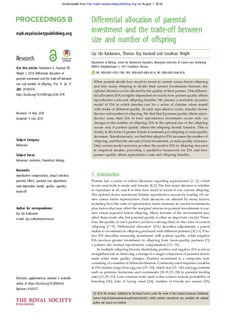| dc.contributor.author | Ratikainen, Irja Ida | |
| dc.contributor.author | Haaland, Thomas | |
| dc.contributor.author | Wright, Jonathan | |
| dc.date.accessioned | 2019-02-20T11:58:33Z | |
| dc.date.available | 2019-02-20T11:58:33Z | |
| dc.date.created | 2018-08-01T11:32:23Z | |
| dc.date.issued | 2018 | |
| dc.identifier.citation | Proceedings of the Royal Society of London. Biological Sciences. 2018, 285 (1884), . | nb_NO |
| dc.identifier.issn | 0962-8452 | |
| dc.identifier.uri | http://hdl.handle.net/11250/2586515 | |
| dc.description.abstract | When parents decide how much to invest in current versus future offspring and how many offspring to divide their current investments between, the optimal decision can be affected by the quality of their partner. This differential allocation (DA) is highly dependent on exactly how partner quality affects reproductive costs and offspring benefits. We present a stochastic dynamic model of DA in which females care for a series of clutches when mated with males of different quality. In each reproductive event, females choose the size and number of offspring. We find that if partner quality affects reproductive costs, then DA in total reproductive investment occurs only via changes in the number of offspring. DA in the optimal size of the offspring occurs only if partner quality affects the offspring benefit function. This is mostly in the form of greater female investment per offspring as male quality decreases. Simultaneously, we find that adaptive DA increases the number of offspring, and thus the amount of total investment, as male quality increases. Only certain model scenarios produce the positive DA in offspring size seen in empirical studies, providing a predictive framework for DA and how partner quality affects reproductive costs and offspring benefits. | nb_NO |
| dc.language.iso | eng | nb_NO |
| dc.publisher | The Royal Society | nb_NO |
| dc.relation.uri | http://rspb.royalsocietypublishing.org/content/285/1884/20181074 | |
| dc.rights | Navngivelse 4.0 Internasjonal | * |
| dc.rights.uri | http://creativecommons.org/licenses/by/4.0/deed.no | * |
| dc.title | Differential allocation of parental investment and the trade-off between size and number of offspring | nb_NO |
| dc.type | Journal article | nb_NO |
| dc.type | Peer reviewed | nb_NO |
| dc.description.version | publishedVersion | nb_NO |
| dc.source.pagenumber | 9 | nb_NO |
| dc.source.volume | 285 | nb_NO |
| dc.source.journal | Proceedings of the Royal Society of London. Biological Sciences | nb_NO |
| dc.source.issue | 1884 | nb_NO |
| dc.identifier.doi | 10.1098/rspb.2018.1074 | |
| dc.identifier.cristin | 1599319 | |
| dc.relation.project | Norges forskningsråd: 223257 | nb_NO |
| dc.relation.project | Norges forskningsråd: 240008 | nb_NO |
| dc.description.localcode | © 2018 The Authors. Published by the Royal Society under the terms of the Creative Commons Attribution License http://creativecommons.org/licenses/by/4.0/, which permits unrestricted use, provided the original author and source are credited. | nb_NO |
| cristin.unitcode | 194,66,10,0 | |
| cristin.unitname | Institutt for biologi | |
| cristin.ispublished | true | |
| cristin.fulltext | original | |
| cristin.qualitycode | 2 | |

